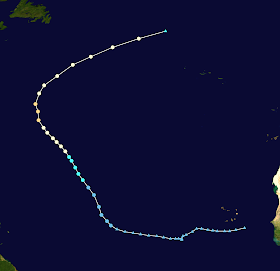21 cyclones attaining tropical depression status,
20 cyclones attaining tropical storm status,
7 cyclones attaining hurricane status, and
3 cyclones attaining major hurricane status.
Before the beginning of the season, I predicted that there would be
15 cyclones attaining tropical depression status,
14 cyclones attaining tropical storm status,
8 cyclones attaining hurricane status, and
4 cyclones attaining major hurricane status.
The average numbers of tropical storms, hurricanes and major hurricanes (over the 30 year period 1991-2020) were 14.4, 7.2, and 3.2, respectively. The eventual numbers for 2023 were well above my prediction for the total number of named storms, though my forecasts for hurricanes and major hurricanes were actually slight overestimates. The (preliminary) Accumulated Cyclone Energy value for the 2023 season is 146, solidly above average. This measure of activity accounts both for strength and duration of tropical cyclones. The exact value sometimes shifts when post-season analysis is complete. Overall, the 2023 season was a mixed bag, well above average in some indicators and near to slightly below in some others. This reflected the unusual conditions that made predicting 2023's outcome particularly tricky.
The 2023 season took place during a fairly strong El Niño event, meaning that equatorial Pacific sea surface temperatures were well above recent normals (the anomalies in different regions are shown in the diagram above). There's a well-established correlation between these anomalies and weather trends throughout the rest of the world, including stronger shear over the Atlantic ocean and a weaker Bermuda high. These tend to led to suppressed hurricane activity and more storms curving out to sea, respectively.
Though several cyclones this season struggled with wind shear, the overall wind shear pattern was not the typical one for an El Niño (see the figure above). Indeed, most of the main development region of the Atlantic basin had below-normal zonal wind shear, where zonal means the component of wind shear in the longitudinal direction. The following diagram illustrates just how unusual this combination of low wind shear and El Niño is, relative to the historical record.
The primary reason that El Niño did not behave normally was the incredibly warm sea surface temperatures in the tropical Atlantic. These warm waters were the result of a combination of anthropogenic global warming and a spring of very weak trade winds, which left the surface portion of the ocean unmixed with cooler waters below. This helps to explain the large number of named storms that formed in 2023. Fortunately for many land areas, however, the other common effect of El Niño did manifest: the Atlantic subtropical ridge was extremely weak all season, allowing many storms to recurve out to sea without affecting land. This included the season's strongest storm, category 5 Hurricane Lee. In fact, 2023 had the lowest death toll and damages from tropical cyclones dating back at least to the 2015 season.
2023's activity also came in intense bursts. The month of June was quite active with three named storms, including two tropical storm formations (Bret and Cindy) in the tropical Atlantic, which is the first such occurrence on record. After that, only one storm formed between June 26 and August 19! The floodgates opened after that, however, with the period from August 20 and September 28 seeing the formation of a whopping 13 named storms (a new record, beating 2020), and 5 hurricanes (tying a record last set in 2012). November, the last month of hurricane season, saw no formations at all.
In my region-by-region predictions, I forecasted that the Caribbean islands would be at high risk this season, and that the coast of the Gulf of Mexico and U.S. east coast would be at relatively low risk. These predictions were reasonably accurate, since the majority of tropical cyclones which affected land this year did so in the Lesser Antilles. Of course, Hurricane Idalia's category 3 landfall in the big bend region of Florida was the one major exception. Idalia caused significant impacts, but they were smaller in magnitude compared to other major hurricane impacts in the region in previous years due to the landfall location and the relatively small radius of maximum winds. Some other notable facts or records from 2023 include:
- Though it wasn't operationally identified at the time, a unnamed subtropical cyclone formed in the northwestern Atlantic on January 16, and became the strongest tropical or subtropical Atlantic cyclone ever recorded in January
- Hurricane Franklin's minimum pressure of 926 mb was the lowest ever recorded in a tropical cyclone that far north in the open Atlantic
- Tropical Storm Philippe claimed the unusual record of longest-lasting Atlantic tropical cyclone with a peak intensity of under 70 mph
The 2023 season was unpredictable from start to finish, but ultimately had relatively mild impacts compared to many other recent years.
Sources: https://www.cpc.ncep.noaa.gov/products/analysis_monitoring/lanina/enso_evolution-status-fcsts-web.pdf, https://yaleclimateconnections.org/2023/11/the-unusual-2023-atlantic-hurricane-season-ends/, https://tropical.colostate.edu/Forecast/2023-11.pdf
















































